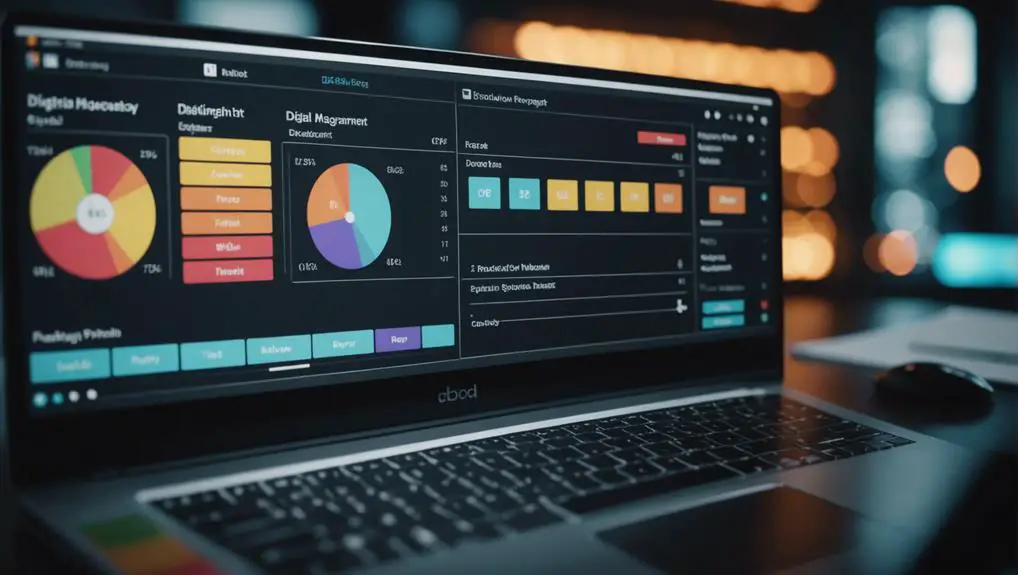Imagine a scenario where a company implemented a new software system to enhance productivity but faced unexpected challenges during the transition.
As you review the change management process for organizational change metrics, consider how aligning metrics with strategic goals can drive successful outcomes.
By understanding the importance of measuring change effectively, you can ensure that your organization adapts seamlessly to transformations.
Key Takeaways
- Define clear KPIs to measure change progress effectively.
- Utilize diverse data sources for comprehensive insights.
- Implement Agile Methodology for flexible adjustments.
- Foster a culture of continual improvement and transparency.
Understanding Change Management Process
When embarking on change management initiatives, understanding the change management process is crucial for successful implementation and sustainable outcomes. One key aspect of this understanding involves identifying and comprehending the various stakeholders impacted by the change. By recognizing the diverse interests, concerns, and levels of influence among stakeholders, you can tailor your strategies to effectively engage and manage their expectations throughout the change process.
Communication strategies play a pivotal role in ensuring stakeholders are well-informed and engaged. Establishing clear, transparent, and consistent communication channels helps build trust and alignment among stakeholders. By crafting targeted messages that resonate with different stakeholder groups and leveraging various communication tools such as town hall meetings, newsletters, and interactive sessions, you can foster a culture of open dialogue and collaboration.
Ultimately, a deep understanding of stakeholders and the implementation of robust communication strategies are foundational elements in driving successful change management initiatives. By prioritizing these aspects, you pave the way for smoother transitions, increased buy-in, and ultimately, the achievement of desired organizational outcomes.
Importance of Organizational Change Metrics
Understanding the significance of organizational change metrics is pivotal in evaluating the effectiveness and impact of change initiatives within your organization. By utilizing metrics to measure changes, you gain valuable insights into the benefits reaped and the overall impact on the organization. These metrics provide a structured approach to assess whether the desired outcomes are being achieved and help in identifying areas that may require further attention or adjustment.
The importance of organizational change metrics lies in their ability to quantify progress, identify successes, and pinpoint areas for improvement. They enable you to track performance against predefined objectives, facilitating informed decision-making and strategic planning. Additionally, these metrics offer a means to communicate progress to stakeholders, fostering transparency and accountability throughout the change process.
Implementing Effective Measurement Strategies
To effectively gauge the impact of organizational change, implementing robust measurement strategies is essential for assessing progress and ensuring alignment with objectives. When measuring effectiveness and tracking progress during organizational change, consider the following key strategies:
- Establish Clear Key Performance Indicators (KPIs): Define specific metrics that directly align with the objectives of the change initiative. These KPIs should be measurable, relevant, and provide valuable insights into the progress and impact of the change.
- Utilize Multiple Data Sources: Collect data from various sources such as surveys, feedback from employees, financial reports, and operational metrics. By triangulating data from different sources, you can obtain a comprehensive view of the change's effectiveness and progress.
- Regular Review and Analysis: Implement a structured process for regularly reviewing and analyzing the collected data. This ongoing analysis will help in identifying trends, areas for improvement, and making informed decisions to optimize the change management process.
Analyzing Data for Informed Decision-Making
Considering the wealth of data available, it's imperative to strategically analyze the information for making well-informed decisions during change management processes. Data analysis plays a crucial role in guiding organizations through transitions effectively. By harnessing the power of data, you can uncover trends, identify areas for improvement, and measure the impact of change initiatives.
Effective data analysis involves more than just collecting information; it requires a deep dive into the numbers to extract actionable insights. When analyzing data, focus on key performance indicators (KPIs) that are directly tied to your change management goals. Look for patterns, correlations, and anomalies that can provide valuable clues for decision-making. Utilize visualizations such as graphs and charts to make complex data more digestible and facilitate understanding.
Informed decision-making hinges on your ability to interpret data accurately. By honing your data analysis skills, you can enhance your capacity to drive successful change initiatives. Remember, data isn't just numbers; it's a powerful tool that can guide you towards transformative outcomes.
Continuous Improvement in Change Initiatives
For optimal success in change initiatives, strive for continual improvement through proactive evaluation and adaptation of strategies based on real-time feedback and data insights. Embracing stakeholder engagement and feedback loops is crucial for fostering a culture of collaboration and transparency.
Here are three key strategies to enhance continuous improvement in change initiatives:
- Utilize Agile Methodology: Implement an iterative approach that allows for flexible adjustments based on evolving requirements and stakeholder feedback. By breaking down the change process into smaller, manageable increments, you can quickly respond to challenges and incorporate lessons learned along the way.
- Establish Ongoing Feedback Loops: Create mechanisms for collecting and analyzing feedback from stakeholders at various stages of the change initiative. This real-time input provides valuable insights that can inform decision-making and drive continuous improvement efforts.
- Encourage a Culture of Learning: Foster a mindset that values experimentation, learning from failures, and adapting strategies based on data-driven insights. By promoting continuous learning and growth, your organization can become more resilient and adaptive in navigating change.
Frequently Asked Questions
How Can Resistance to Change Be Effectively Addressed Within an Organization?
Addressing resistance to change within your organization requires proactive change strategies. Engage employees early, communicate openly, provide support, and involve them in the process. Acknowledge concerns, listen actively, and demonstrate the benefits of the proposed changes.
What Are Some Common Pitfalls to Avoid When Measuring Organizational Change Metrics?
When measuring organizational change metrics, avoid the pitfall of inadequate data collection. Effective communication is key. Ensure all stakeholders understand the metrics being used and why. Transparency builds trust and buy-in, enhancing the success of change initiatives.
How Can Organizations Ensure That the Data Collected for Change Initiatives Is Accurate and Reliable?
To ensure accurate and reliable data for change initiatives, focus on data validation techniques. Engage stakeholders early to align on metrics and validation processes. This strategic approach builds trust in data quality, enhancing decision-making and successful change outcomes.
What Role Does Leadership Play in Driving Successful Change Management Processes?
To drive successful change management processes, leadership impact is crucial. Effective change communication, setting clear expectations, and leading by example are vital. Engage with stakeholders, provide support, and inspire commitment to navigate organizational transformations successfully.
How Can Organizations Sustain Long-Term Change and Avoid Reverting Back to Old Habits and Practices?
So you want to keep those changes intact, huh? Well, sustainability strategies are your friends. Use behavioral reinforcement to keep everyone in line. Remember, old habits die hard, but with the right tactics, you got this!
Conclusion
You now have the tools to effectively measure organizational change and drive successful outcomes.
By implementing data-driven strategies, like tracking employee engagement levels during a merger, you can make informed decisions and drive continuous improvement in your change initiatives.
Remember, measuring change isn't just about numbers – it's about understanding the impact on your people and your organization.
Stay proactive, stay strategic, and watch your transformation efforts thrive.





